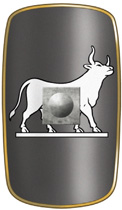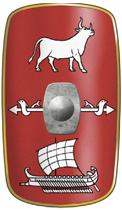Legions of Rome (25 page)
Authors: Stephen Dando-Collins

9TH HISPANA LEGION

LEGIO IX HISPANA
Spain’s 9th Legion
ORIGIN OF TITLE:
Awarded by Augustus for meritorious service in the Cantabrian Wars.
EMBLEM:
Bull (probably).
BIRTH SIGN:
Capricorn (probably).
FOUNDATION:
Probably founded by Pompey the Great, c. 55 BC.
RECRUITMENT AREA:
Initially Spain.
POSTINGS:
Hispania, Siscia, Pannonia, Britannia, Lindum, Britannia.
BATTLE HONORS:
Cantabrian War, 29-19 BC.
Tacfarinas’ Revolt, AD 19-21.
Invasion of Britain, AD 43.
Agricola’s British campaigns, AD 77-84.
Domitian’s German campaign, AD 83.
Battle of Mons Graupius, AD 84.
THE LEGION THAT DISAPPEARED
A legion that was decimated by Julius Caesar, savaged in Boudicca’s revolt in Britain, yet was victorious for Agricola in Scotland. It then famously disappeared from the face of the earth; an old answer to the mystery of where and when is supported by surprising evidence
.
Sometime after
AD
120, the 9th Hispana Legion disappeared from the face of the earth, with no explanation given in any classical text or on any inscription. Early twentieth-century historians came to believe that the legion, the last known posting of which was northern Britain, had been wiped out by Caledonian tribes in Scotland in around
AD
122. Later theories had the legion being destroyed in Judea during the Second Jewish Revolt of
AD
132–135, or in Armenia in
AD
161 at the start of the reign of Marcus Aurelius. As detailed in
Disappearance of the 9th
, the preponderance of evidence today points back to the original hypothesis, that of annihilation at the hands of the Caledonians in
AD
122.
The republican 9th Legion served under Caesar, most likely during his 61
BC
posting as governor of Further Spain then most definitely during the Gallic War and
the Civil War. At the beginning of the imperial era it served in Augustus’ Cantabrian Wars in Spain, from which it derived its title, and subsequently in the Pannonian War, after which it was based at Siscia in Pannonia.
In
AD
43 the 9th Hispana was one of the four legions in Claudius’ invasion of Britain, after which it was stationed at Lindum, today’s Lincoln. In
AD
60, four cohorts of the legion were led by its rash young commander, Petilius Cerialis, into an ambush by Boudicca’s rebel Britons. The cohorts were wiped out, but Cerialis and some cavalry survived. Unusually, in
AD
61, the Palatium transferred 2,000 men from a legion on the Rhine—apparently the 21st Rapax at Vindonissa—to the 9th Hispana, to replace the lost cohorts and bring the legion up to strength at a time when rebellion still simmered in southern Britain.
The 9th Hispana later transferred north to Eburacum (York), and, after
AD
108, further north again to Carlisle, where it remained until its disappearance.

10TH FRETENSIS LEGION

LEGIO X FRETENSIS
10th Legion of the Strait
ORIGIN OF TITLE:
Refers to a naval engagement prior to the imperial era.
EMBLEM:
Bull, warship and dolphin.
BIRTH SIGN:
Taurus (probably).
FOUNDATION:
Disputed. Long thought to be a legion created by Octavian prior to 42 BC. A more modern interpretation makes it Julius Caesar’s original 10th, founded by him in 61 BC.
RECRUITMENT AREA:
Originally Further Spain.
POSTINGS:
Macedonia, Syria, Cyrrhus, Judea, Masada, Jerusalem, Judea, Aela.
BATTLE HONORS:
Macedonian conflict, 19 BC-AD 2.
Corbulo’s First Armenian campaign, AD 52-54.
Corbulo’s Second Armenian campaign, AD 62.
Jewish Revolt, AD 66-71.
Second Jewish Revolt, AD 132-135.
NOTABLE COMMANDER:
Marcus Ulpius Traianus, father of the future emperor Trajan.
THE FAMOUS TENTH, OR NOT THE FAMOUS TENTH?
For centuries historians were convinced that this was not Julius Caesar’s famous 10th, but a new perspective suggests that it was. Rampaging through Armenia and unstoppable at Jerusalem and Masada, it was almost wiped out in the Second Jewish Revolt
.
The 10th Legion which served Caesar during the Gallic War and much of the Civil War of 49–45
BC
was the most famous legion of its day. Raised by Caesar in person, the 10th Legion swiftly became his favorite unit. “Caesar placed the highest confidence in this legion for its bravery,” Caesar himself wrote of the 10th in 58
BC
, only months after he began campaigning in Gaul. [Caes.,
GW
,
I
, 40]
Caesar said that the men of the 10th commissioned their military tribunes to thank him for his high opinion of them, and to assure him that they were ready to take the field at any moment. [Ibid., 41] Over the next fourteen years the 10th served
on the prestigious but dangerous extreme right of his battle lines and helped him achieve his greatest victories.
Of the loyalty of the 10th, Caesar had no doubt, and he told the legion that it should serve as his bodyguard. [Ibid., 40] This led to a celebrated event. When, in that same year, 58
BC
, Caesar agreed to a parley with a German king, Ariovistus, and the king stipulated that both leaders should only bring a mounted escort to the meeting, Caesar grew suspicious of his own allied Gallic cavalry. Telling the cavalrymen to dismount, Caesar gave their horses to the infantrymen of the 10th, on whose devotion he felt he could rely absolutely. [Ibid., 42]
In response to this, one of the legionaries of the 10th remarked, no doubt with a grin, “Caesar is being better than his word. He promised to make the 10th his bodyguard, and now he’s making Equestrians of us!” [Ibid.] The Equestrians that the soldier was referring to were the Equestrian Order. In modern times, this remark has sponsored much debate among historians about the identity of Caesar’s 10th Legion, for there were two 10th legions during the imperial era, the 10th Fretensis and the 10th Gemina. One of them was the direct descendant of Caesar’s 10th. But which one?
German historian Theodor Mommsen claimed that the 10th Fretensis could not have been Caesar’s original 10th Legion, and his claim stood on two apparently firm hypotheses. The first related to the title “Fretensis.” This term, which literally means “of the strait,” had puzzled scholars for centuries. Mommsen proposed that the title derived from fretum Siciliense, the Strait of Sicily, which we know as the Strait of Messina, that narrow stretch of water between the toe of Italy and the island of Sicily. This 10th
Fretensis Legion, said Mommsen, must have been a new creation of Octavian that fought for him during his epic sea battles against Sextus Pompey off the coast of Sicily in 36
BC
, while the original 10th served under Mark Antony in the East.
During these Sicilian sea battles, Octavian’s deputy Marcus Agrippa put large numbers of men from Octavian’s legions aboard ships of his fleet, and it was these men, fighting as marines, who won the Battles of Mylae and Naucholus for Octavian. While a 1st Legion and a 13th Legion are mentioned by classical historian Appian as
being in the general area at the time, none of the legions that Agrippa used to achieve his naval victories for Octavian was ever identified by classical texts or inscriptions.
Mommsen, noting that the 10th Fretensis Legion showed warships on the coins minted for the legion, concluded that the 10th Fretensis had been one of those legions that took part in Agrippa’s naval victories against Sextus Pompey and had appropriated the title Fretensis to commemorate that fact. It is generally accepted by historians that Caesar’s original 10th Legion joined Mark Antony in late 44
BC
and continued to serve him until the 31
BC
Battle of Actium. Therefore, went the Mommsen argument, if the 10th Fretensis fought for Octavian off Sicily in 36
BC
, there was no way it could have then ended up in Antony’s army at Actium by 31
BC
; with relations between Octavian and Antony souring from 36
BC
, there was neither the will on Octavian’s part to send Antony troops nor an opportunity for the 10th Fretensis Legion to have gone from Italy to the East to join Antony. Consequently, so went the Mommsen theory, the 10th Gemina legion created by Augustus in 30
BC
from Antony’s 10th must have been the direct descendant of Caesar’s 10th—not the 10th Fretensis.
In support of Mommsen’s conclusion he, and others, have pointed to Italian gravestones from some time after 41
BC
for men who had served in a “Legio X Equestris.” The “Equestris” in these inscriptions, some said, was a reference to the occasion in 58
BC
when Caesar mounted men of his 10th Legion as his bodyguard—the Equestrians of the legionary’s quip. This, the argument goes, definitely made these men veterans of Caesar’s original 10th.
Mommsen’s theory was said to be supported by an inscription on an altar at Rome, dating from after 2
BC
, dedicated by centurions and other ranks of the “Legio X Gemina Equestris.” According to the Mommsen “school,” this inscription made the 10th Gemina Legion and the 10th Equestris Legion one and the same; accordingly, the 10th Gemina Legion was Caesar’s 10th Legion, and, conversely, the 10th Fretensis was not.
This all makes sense until each skein of the argument is tested for strength; the argument then begins to fall apart. Keppie points out that the unique altar reference to “Legio X Gemina Equestris” makes this the only legion of the Civil War era to have been given two titles in the one inscription. [Kepp.
CVSI
, 2.2, n. 44] Secondly, this inscription is the only one ever found that links the 10th Gemina and the otherwise unknown 10th “Equestris” Legion. Thirdly, the date of this lone inscription at Rome
is at least forty-two years after the death of Caesar, and possibly somewhat later, putting it at long remove from Caesar.
Then there is the term Equestris itself. It was only assumed in modern times that the term applied to Caesar and the brief incident relating to men of his 10th on horseback. No classical author, including Caesar himself, ever wrote that men of the 10th Legion subsequently adopted the title Equestris.
